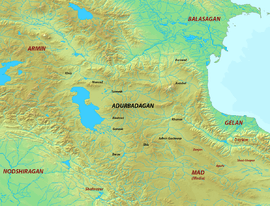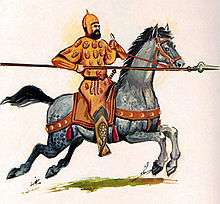Daylamites

The Daylamites or Dailamites (Middle Persian: Daylamig; Persian: دیلمیان Deylamiān) were an Iranian people inhabiting the mountainous regions of northern Iran on the southern shore of the Caspian Sea.[1] They were employed as soldiers from the time of the Sasanian Empire, and long resisted the Muslim conquest of Persia and subsequent Islamization. In the 930s, the Daylamite Buyid dynasty emerged and managed to gain control over much of modern-day Iran, which it held until the coming of the Seljuq Turks in the mid-11th century.
Origins, language and equipment
The Daylamites lived in the highlands of Daylam, part of the Alborz range, between Gilan and Tabaristan. However, the earliest Zoroastrian and Christian sources indicate that the Daylamites originally came from Anatolia near the Tigris,[2] where Iranian ethnolinguistic groups, including Zazas, live today.[3] They spoke the Daylami language, a now-extinct northwestern Iranian variety similar to that of the neighbouring Gilites.[4] During the Sasanian Empire, they were employed as high-quality infantry.[5] According to the Byzantine historians Procopius and Agathias, they were a warlike people and skilled in close combat, being armed each with a sword, a shield and spears or javelins.
History
Pre-Islamic period
Seleucid and Parthian period
The Daylamites first appear in historical records in the late second century BCE, where they are mentioned by Polybius, who erroneously calls them Ἐλυμαῖοι ("Elamites") instead of Δελυμαῖοι ("Daylamites"). In the Middle Persian prose Kar-Namag i Ardashir i Pabagan, Artabanus V of Parthia (r. 208–224) summoned all the troops from Ray, Damavand, Daylam, and Padishkhwargar to fight the newly established Sasanian Empire. According to the Letter of Tansar, during this period, Daylam, Gilan, and Ruyan belonged to the kingdom of Gushnasp, who was a Parthian vassal but later submitted to Sasanian emperor Ardashir I (r. 224–242).[6]
Sasanian period

The descendants of Gushnasp were still ruling until in ca. 520, when Kavadh I (r. 488-531) appointed his eldest son, Kawus, as the king of the former lands of the Gushnaspid dynasty.[6] In 522, Kavadh I sent an army under a certain Buya (known as Boes in Byzantine sources) against Vakhtang I of Iberia. This Buya was a native of Daylam, which is proven by the fact that he bore the title wahriz, a Daylamite title also used by Khurrazad, the Daylamite military commander who conquered Yemen in 570 during the reign of Khosrow I (r. 531-579),[6] and his Daylamite troops would later play a significant role in the conversion of Yemen to the nascent Islam.[4]
Daylamites also took part in the siege of Archaeopolis in 552. They supported the rebellion of Bahrām Chōbin against Khosrow II, but he later employed an elite detachment of 4000 Daylamites as part of his guard.[4]

Some Muslim sources maintain that following the Sasanian defeat in the Battle of al-Qādisiyyah, the 4000-strong Daylamite contingent of the Sasanian guard, along with other Iranian units, defected to the Arab side, converting to Islam.[7]
Islamic period
Resistance to the Arabs


.jpeg)
The Daylamites managed to resist the Arab invasion of their own mountainous homeland for several centuries under their own local rulers.[4][8] Warfare in the region was endemic, with raids and counter-raids by both sides. Under the Arabs, the old Iranian fortress-city of Qazvin continued in its Sasanian-era role as a bulwark against Daylamite raids. According to the historian al-Tabari, Daylamites and Turkic peoples were considered the worst enemies of the Arab Muslims.[4] The Abbasid Caliphate penetrated the region and occupied parts of it, but their control was never very effective.
During the reign of Harun al-Rashid, several Shi'i Muslims fled to the Daylamites, most of whom remained pagan, with a few Zoroastrians and Christians, to escape persecution. Among these refugees were some Alids, who began the gradual conversion of the Daylamites to Shia Islam.[4][9] Nevertheless, a strong Iranian identity remained ingrained in the peoples of the region, along with an anti-Arab mentality. Local rulers such as the Buyids and the Ziyarids, made a point of celebrating old Iranian and Zoroastrian festivals.[8]
The Daylamite expansion
In the mid ninth-century, need increased in the Abbasid Caliphate for mercenary soldiers in the Royal Guard and the army, thus they began recruiting Daylamites, who although during this period were not as strong in numbers as the Turks, Khorasanis, the Farghanis, and the Egyptian Arab tribesmen of the Maghariba. From 912/3 to 916/7, a Daylamite soldier, Ali ibn Wahsudhan, was chief of police (ṣāḥib al-shurṭa) in Isfahan during the reign of al-Muqtadir (r. 908–929). For many decades, "it remained customary for the Caliph's personal guards to include the Daylamites as well as the ubiquitous Turks".[10]
Culture
Religion
The Daylamites were most likely adherents of some form of Iranian paganism, while a minority of them were Zoroastrian and Christian. According to al-Biruni, the Daylamites and Gilites "lived by the rule laid down by the mythical Afridun."[6] The Church of the East had spread among them due to the activities of John of Dailam, and bishoprics are reported in the remote area as late as the 790s, while it is possible that some remnants survived there until the 14th century.[4]
Customs, equipment and appearance

_4.jpg)
Many habits and customs of the Daylamites have been recorded in historical records. Their men were strikingly tough and capable of lasting terrible privations. They were armed with javelins and battle axes, and had tall shields painted in gray colours. In battle, they would usually form a wall with their shields against the attackers. Some Daylamites would use javelins with burning naphtha. A poetic portrayal of Daylamite armed combat is present in Fakhruddin As'ad Gurgani's Vis and Rāmin. A major disadvantage of the Daylamites was the low amount of cavalry that they had, which compelled them to work with Turkic mercenaries.
The Daylamites exaggeratedly mourned over their dead, and even over themselves in failure. In 963, the Buyid ruler of Iraq, Mu'izz al-Dawla, popularized Mourning of Muharram in Baghdad, which may have played a part in the evolution of the ta'zieh.
The medieval Persian geographer Estakhri describes the Daylamites as a bold but inconsiderate people, being thin in appearance and having fluffy hair. They practised agriculture and had herds, but only a few horses. They also grew rice, fished, and produced silk textiles. According to al-Muqaddasi, the Daylamites were handsome and had beards. According to the author of the Hudud al-'Alam, the Daylamite women took part in agriculture like men. According to Rudhrawari, they were "equals of men in strength of mind, force of character, and participation in the management of affairs." Furthermore, the Daylamites also strictly practised endogamy.
References
- ↑ Fishbein, Michael (1990). The History of al-Tabari Vol. 21: The Victory of the Marwanids A.D. 685-693/A.H. 66-73. SUNY Press. ISBN 978-0-7914-0222-1., page 90, note 336
- ↑ Dadagi, Farnbagh. Bahar, Mehrdad. "Bundahishn." Tus, 1991
- ↑ Extra, Guus; Gorter, Durk (2001). The Other Languages of Europe: Demographic, Sociolinguistic, and Educational Perspectives. Multilingual Matters. ISBN 978-1-85359-509-7.
- 1 2 3 4 5 6 7 Daylamites at Encyclopædia Iranica
- ↑ Frrokh (2007), pp. 201, 224, 231
- 1 2 3 4 Madelung & Felix 1995, pp. 342-347.
- ↑ Farrokh (2007), p. 269
- 1 2 Price (2005), p. 42
- ↑ Farrokh (2007), pp. 274-275
- ↑ Bosworth
Sources
- Madelung, W. (1975). "The Minor Dynasties of Northern Iran". In Frye, R.N. The Cambridge History of Iran, Volume 4: From the Arab Invasion to the Saljuqs. Cambridge: Cambridge University Press. pp. 198–249. ISBN 978-0-521-20093-6.
- Bosworth, C. E. (1975). "Iran under the Buyids". In Frye, R. N. The Cambridge History of Iran, Volume 4: From the Arab Invasion to the Saljuqs. Cambridge: Cambridge University Press. pp. 250–305. ISBN 0-521-20093-8.
- Nagel, Tilman (1990). "BUYIDS". Encyclopaedia Iranica, Vol. IV, Fasc. 6. London u.a.: Routledge & Kegan Paul. pp. 578–586.
- Amedroz, Henry F.; Margoliouth, David S., eds. (1921). The Eclipse of the ‘Abbasid Caliphate. Original Chronicles of the Fourth Islamic Century, Vol. V: The concluding portion of The Experiences of Nations by Miskawaihi, Vol. II: Reigns of Muttaqi, Mustakfi, Muti and Ta'i. Oxford: Basil Blackwell.
- Wilferd Madelung, Wolfgang Felix, (1995). "DEYLAMITES". Encyclopaedia Iranica, Vol. BII, Fasc. 4. pp. 342–347.
- Donohue, John J. (2003). The Buwayhid Dynasty in Iraq 334h., 945 to 403h., 1012: Shaping Institutions for the Future. ISBN 9789004128606. Retrieved 3 February 2014.
- Kabir, Mafizullah (1964). The Buwayhid Dynasty of Baghdad, 334/946-447/1055. Retrieved 3 February 2014.
- Price, Massoume (2005). Iran's diverse peoples. ABC-CLIO. ISBN 978-1-57607-993-5.
- Potts, Daniel T. (2014). Nomadism in Iran: From Antiquity to the Modern Era. London and New York: Oxford University Press. pp. 1–558. ISBN 9780199330799.
- Al-Tabari, Abu Ja'far Muhammad ibn Jarir (1985–2007). Ehsan Yar-Shater, ed. The History of Al-Ṭabarī. 40 vols. Albany, NY: State University of New York Press.
- Potts, Daniel T. (2012). "ARABIA ii. The Sasanians and Arabia". Encyclopaedia Iranica.
- Kennedy, Hugh N. (2007). The Great Arab Conquests: How the Spread of Islam Changed the World We Live In. Philadelphia, PA: Da Capo Press. ISBN 978-0-306-81740-3.
- Zakeri, Mohsen (1995). Sasanid Soldiers in Early Muslim Society: The Origins of 'Ayyārān and Futuwwa. Otto Harrassowitz Verlag. pp. 1–391. ISBN 3447036524.